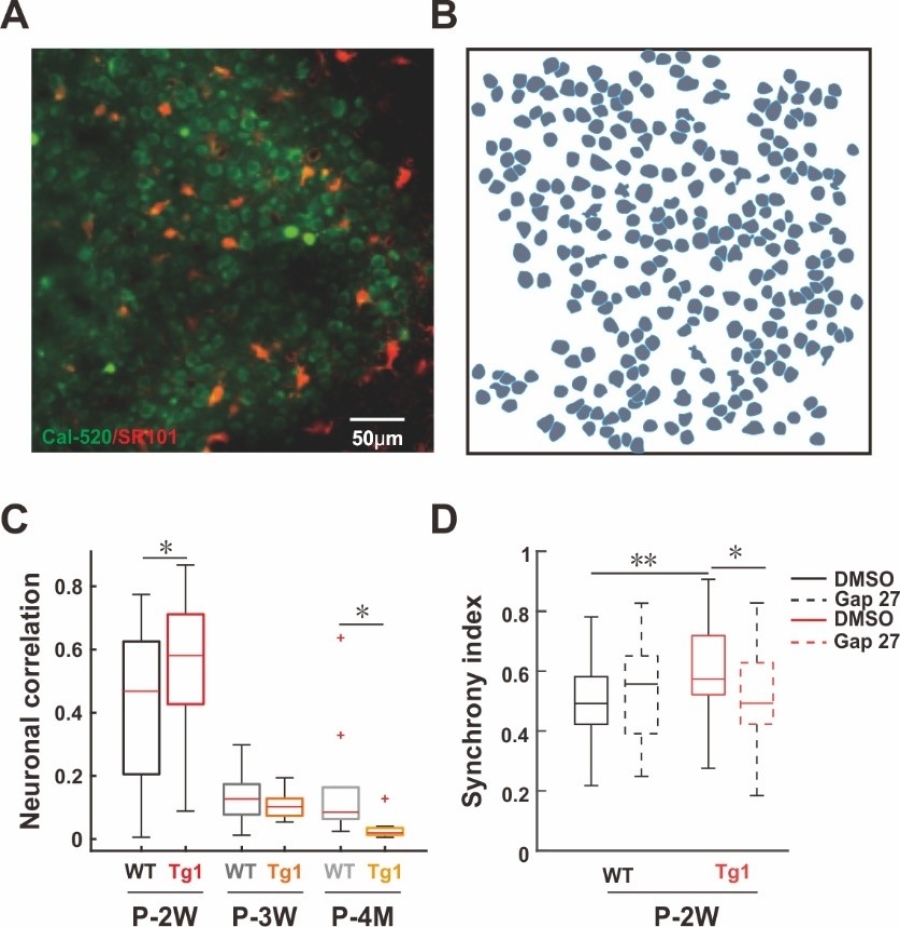Time:2022-02-18
A recent study published in Neuroscience Bulletin demonstrated that astrocytic gap junctions facilitate the abnormal neuronal synchrony in young autistic model MeCP2 overexpressing mice, revealing the potential role of the astrocyte network in the pathogenesis of autism. This work was performed by researchers in Dr. XU Hua-tai’s lab at the Institute of Neuroscience, Center for Excellence in Brain Science and Intelligence Technology of the Chinese Academy of Sciences, State Key Laboratory of Neuroscience.
Abnormality in synchronous neuronal activity has been widely detected by brain imaging of autistic patients, but its underlying neural mechanism remains unclear. Combining in vivo two-photon calcium imaging with multichannel electrophysiological whole-cell patch-clamp recordings, they found gap junctions among astrocytes significantly contribute to the aberrant neuronal synchronization in Tg1 mice over-expressing human autism risk gene MeCP2 (A widely used mouse model of Autism Spectrum Disorder). Using in vivo two-photon calcium imaging on the somatosensory cortex of Tg1 mice, the authors carried out a longitudinal study from early postanal development stage to adulthood. They found, compared with wild-type control mice, Tg1 mice exhibited higher neural synchrony at the early postnatal stage but lower at adulthood. Whole-cell recording on neuronal pairs from acute brain slices further revealed that higher neuronal synchrony in the young postnatal Tg1 mice could be attributed mainly to the more prevalent giant slow inward currents (SICs). In addition, both in vivo and acute brain slice calcium imaging demonstrated the hyperactive astrocytes in Tg1 mice at early postnatal stage. Blocking the astrocytic gap junctions in vivo markedly decreased the generation of SIC on neurons, and also reduced the neural synchrony level in young Tg1 brain. Thus, astrocytic gap junction propagated the effects for hyperactive astrocyte on neuronal network, triggering synchronized SICs on neurons within larger distance, further promoted the abnormally high neural synchrony for neocortical network in Tg1 brain at early postnatal stage. Their results demonstrated the critical role of astrocytic-neuronal network communication in the pathogenesis of autism disorder.
This work entitled “Astrocytic Gap Junctions Contribute to Aberrant Neuronal Synchronization in a Mouse Model of MeCP2 Duplication Syndrome” was published online in Neuroscience Bulletin on Feb 11, 2022. This work was supported by the Chinese Academy of Sciences, Shanghai Municipality, National Natural Science Foundation of China.

A, Typical field view of in vivo two-photon imaging from layers 2/3 of somatosensory cortex, in which neurons stained by Cal-520 AM (green), and astrocytes are also labeled by sulforhodamine 101 (red) (scale bar, 50 μm). B, Regions of interest for neurons and astrocytes drawn according to the visible cell bodies shown in A. C, Age-dependent abnormality of neuronal synchrony in the Tg1 brain. D, Blocking astrocytic gap junctions abolishes the hypersynchrony in young Tg1 mice.
 附件下载:
附件下载: